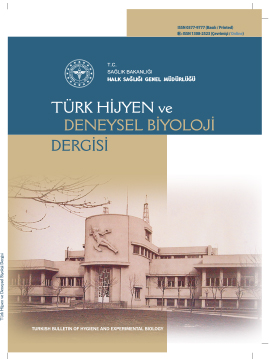
Bu eser Creative Commons Alıntı-GayriTicari-Türetilemez 4.0 Uluslararası Lisansı ile lisanslanmıştır.













Evaluation of systemic tissue involvement in mice following intraperitoneal inoculation of Toxoplasma gondii RH Ankara strain
Emine Şamdancı - Türkmen1, Ayşegül Taylan - Özkan2, Cahit Babür3, Mesut Mungan3, Engin Aydın11Inonu University, Faculty Of Medicine, Department Of Medical Pathology, Malatya, Turkey2Hitit University, Faculty Of Medicine, Department Of Medical Microbiology, Corum, Turkey
3Public Health Institution Of Turkey, National Parasitology Reference Laboratory, Ankara, Turkey
OBJECTIVE: This study aimed to pathologically evaluate systemic tissue involvement in acute toxoplasmosis in mice inoculated with Toxoplasma gondii RH Ankara strain.
METHODS: Forty-two Mus musculus albino mice were divided into four groups with the control group receiving no inoculation, the group consisting of mice that were not sacrificed after intraperitoneal inoculation and the groups consisting of mice euthanasia were performed
on day runner up or day fourth following intraperitoneal inoculation. A 48-50-hour intraperitoneal passage of T. gondii RH Ankara strain in mice was used for inoculation
and each mouse received 5x104 tachyzoites. The mice sacrificed by euthanasia were macroscopically examined and then collected tissue samples fixed in 10% formalin.
The preparations set by from the tissues blocked in paraffin were stained with hematoxylin-eosin and histopathological examination was performed.
RESULTS: Necrosis in the serosa of the intestine and parenchyma of the liver, spleen, kidneys, pancreases
and omentum and many free groups of tachyzoites were observed. Tachyzoites were identified in alveolar capillary lumens in the lungs. No pathological finding was observed in the cerebrum and cerebellum but few tachyzoites. It was observed that tissue necrosis and the
density of Toxoplasma gondii tachyzoites were directly proportional to the duration of post inoculation. All infected mice that received no intervention died on day sixth. In this study in mice, it was found that T. gondii RH Ankara strain induced the same pathological findings as the RH strain belonging to the virulent Type I group.
CONCLUSION: Mice inoculation can be used for diagnosis and this model may also be used in studies investigating vaccination, drugs and pathogenesis.
Toxoplasma gondii RH Ankara suşu ile intraperitoneal olarak enfekte edilen farelerde sistemik doku tutulumunun değerlendirilmesi
Emine Şamdancı - Türkmen1, Ayşegül Taylan - Özkan2, Cahit Babür3, Mesut Mungan3, Engin Aydın11İnönü Üniversitesi, Tıp Fakültesi, Tıbbi Patoloji Anabilim Dalı, Malatya2Hitit Üniversitesi Tıp Fakültesi, Tıbbi Mikrobiyoloji Anabilim Dalı, Çorum
3Türkiye Halk Sağlığı Kurumu, Ulusal Parazitoloji Referans Laboratuvarı, Ankara
AMAÇ: Bu çalışmada, intraperitoneal yolla Toxoplasma gondii RH Ankara suşu inoküle edilen farelerde oluşan akut tokzoplazmozisde sistemik doku tutulumunun patolojik olarak değerlendirilmesi amaçlanmıştır.
YÖNTEMLER: Mus musculus varyete albino cinsi 42 adet fare, herhangi bir inokülasyonun yapılmadığı
kontrol grubu, intraperitoneal inokülasyondan sonra sakrifiye edilmeyen ve intraperitoneal inokülasyondan ikinci gün ve dördüncü gün sakrifiye edilenler olmak üzere dört gruba ayrılmıştır. Farelerin intraperitoneal inokülasyonunda T. gondii RH Ankara suşunun farelerdeki
48-50 saatlik intraperitoneal pasajları kullanılmış ve her bir fareye 5x104 takizoit verilmiştir. Sakrifiye edilen hayvanlar makroskobik olarak incelendikten sonra alınan doku örnekleri %10 formalinde tespit edilmiştir. Parafin bloklara alınan dokulardan hazırlanan preparatlar
hematoksilen-eozin ile boyanarak histopatolojik olarak incelenmiştir.
BULGULAR: Karaciğer, dalak, ince bağırsaklar, böbreklerin parankimi ve serozasında nekrozlar ve çok sayıda serbest takizoit grupları gözlenmiştir. Akciğerin alveolar kapiller lümenlerinde de takizoitler
saptanmıştır. Beyin ve beyincikte ise herhangi anlamlı bir patolojik değişiklik izlenmemiştir. Dokulardaki nekroz ve Toxoplasma gondii takizoidlerinin yoğunluğunun, inokülasyon süresi ve temas yüzeyi ile doğru orantılı olduğu gözlenmiştir. Herhangi bir müdahalede bulunulmayan
enfekte farelerin tamamı altıncı günün sonunda ölmüştür. Bu çalışmada T. gondii RH Ankara suşunun farelerde virulan Tip I gruba bağlı RH suşlarındakine benzer patolojik bulgular oluşturduğu belirlenmiştir.
SONUÇ: Fare inokülasyonu tanı amacıyla kullanılabileceği gibi aşı, ilaç ve patogeneze yönelik çalışmalarda da bu modelden yararlanılabilir.
Manuscript Language: English
(1999 downloaded)


